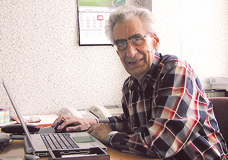
Yan L. Ziman (1922 – 2009)
Headed the department from 1972 to 1988.
Yan L. Ziman, a veteran of the Second World War, awarded four military decorations and fourteen medals. An honorary civil aviation navigator, a laureate of the USSR State prize, an honored scientist of Russia, a doctor of technical sciences, a professor.
Yan Ziman came to the institute in 1967. By this time he had already flown almost four hundred times as a bomber navigator during the war. He had a degree from MIIGAIK and was experienced in both teaching and scientific research in navigation and aerial photosurveying. In 1972 Yan Ziman created his own department in the institute – a department for studying the Earth from space.
Almost immediately the department was able to equip and launch a special plane-laboratory with the most up-to-date multi-zone photographic and optical-electronic devices. The latter’s task was to model images taken from space. At the same time the department began to prepare the “Raduga” project which was carried out in 1976 on the manned s/c “Soyuz-22”.
In the mid 1970s the department began to prepare a new space experiment “Fragment”. The developed multi-zone scanning device, very complex for that time functioned on board the “Meteor-Priroda” s/c for almost four years and provided for a huge amount of scientific and practical data.
In 1975, at the “Intercosmos” Council, a new working group for remote sensing of the Earth was formed. In 1980 the first issue of the new academic journal “Earth Research from space” appeared. Yan Ziman became the chief editor of this journal.
The planetary studies became the new field of the department’s research and Yan Ziman interests. Research was carried out regarding the nucleus of Halley’s comet, Phobos and Mars. Special scientific research complexes were created for each of these projects.
The success of all these projects was largely due to the principles on which Yan Ziman built the foundations of his department, and maintained the atmosphere of high professionalism and comradeship.
A career of sixty eight years. Forty seven years in space science and technology. More than 150 scientific publications and 30 inventions, seven of which have been patented abroad, the leadership of many pioneering space experiments.




